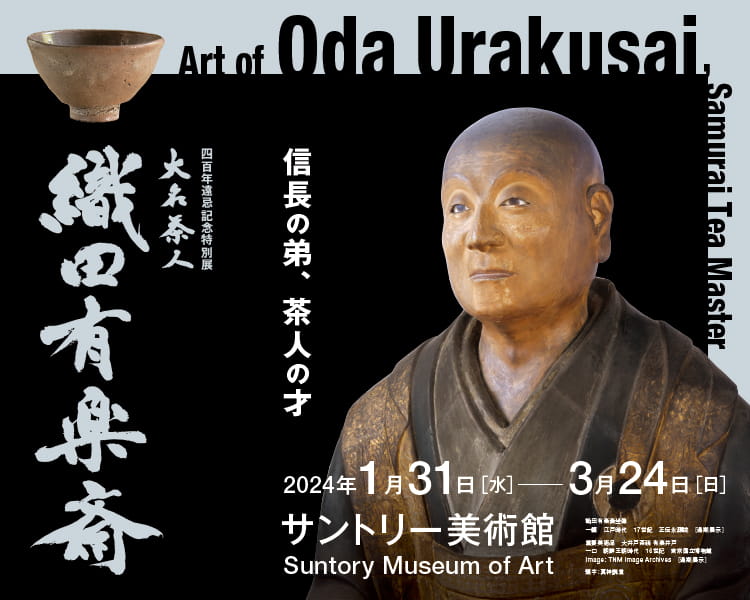- Calendar
- Online Ticket Sales
- Access
- JA
- EN
Art of Oda Urakusai, Samurai Tea Master
January 31 to March 24, 2024
*Download the list of changes in works on display
*There will be an exhibition change during the course of exhibition.


Urakusai, also known as Oda Nagamasu, was born in 1547 as a son of Oda Nobuhide and a younger brother of Oda Nobunaga. After serving as a military leader, in his later years he restored the temple Shoden-in, a subtemple of Kennin-ji Temple in Kyoto. Urakusai then lived in secluded retirement at the restored temple. A teahouse (named Jo-an) he built within the grounds of what was then Shoden-in Temple has been listed as a National Treasure. Replicas of Jo-an have since been built in various locations in Japan. Shoden-in was renamed Shoden Eigen-in amid the modernization of Japan toward the end of the 19th century. Today, Shoden Eigen-in is still custodian of many cultural assets related to Urakusai.
However, whereas Urakusai is renowned today as a man of culture, he also presents a darker, more solemn images as Nagamasu, the samurai warrior. In 1574, Nagamasu was given the Chita district in Owari Province, which today is part of Aichi Prefecture, and went on to serve Oda Nobutada, the eldest son of his brother, Nobunaga. During the Honno-ji Incident in 1582, Nagamasu fled Nijo Imperial Palace, leaving Nobutada, and went to serve his nephew, Nobukatsu. Back at the Palace, Nobutada committed ritual suicide, upon which the Kyoto townspeople ridiculed Nagamasu as ‘the guy who ran away after urging his master to kill himself’. Following relocation to Nobukatsu’s territory, Nagamasu displayed his presence in various ways, including negotiating peace between Tokugawa Ieyasu and Toyotomi Hideyoshi. After Nobukatsu was dismissed from his official post, Nagamasu became an adviser to Toyotomi Hideyoshi. During the Battle of Sekigahara, he fought for the Eastern Army (Tokugawa Ieyasu’s side). After the battle, while remaining with the Toyotomi clan, he also maintained relations with the Tokugawa side. Nagamasu left his master, with the permission of Tokugawa Ieyasu, before the summer campaign in the siege of Osaka Castle.
Nagamasu rode the currents of the times, serving under three great rulers of the eraーOda, Toyotomi and Tokugawa. He reached the end of a long and eventful life at 75 years, having passed his final years in secluded retirement as Urakusai, in Kyoto. What was the nature of Urakusai’s innermost thoughts during that time? While having survived many years of warfare, Urakusai’s sense of beauty still permeates and is regarded as a standard for tea ceremony today.
On the 400th anniversary of his death, Shoden Eigen-in undertook reexamination of the cultural assets in the temple’s possession. This exhibition is based on the findings of that survey, and offers a redefinition of the person known as Oda Urakusai.
| Period |
January 31 to March 24, 2024 *Download the list of changes in works on display |
||||||
|---|---|---|---|---|---|---|---|
| Hours |
10:00-18:00 *Friday and Saturday 10:00-20:00 *Open until 20:00 on February 11, 22 and March 19 |
||||||
| Closed |
Tuesdays *Open until 20:00 on March 19 |
||||||
| Admission |
Elementary, junior high school students and under are free. |
||||||
| Discount |
◇100 Yen Discount *Only one discount per person |
||||||
| Audio Guide |
¥600 English audio guide available |
||||||
| Organized by |
Suntory Museum of Art, Shoden Eigen-in Temple, The Yomiuri Shimbun |
||||||
| Sponsored by |
Mitsui Fudosan Co., Ltd., Suntory Holdings Limited |
||||||
| With the special support of |
Executive committee of commemorating the 400th anniversary of Oda Urakusai, Elysium Co. Ltd., NTT Communications Corporation, Sony Marketing Inc. |
*Unauthorized reproduction or use of texts or images from this site is prohibited.
